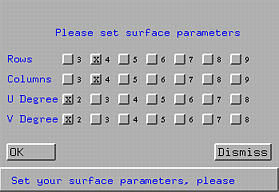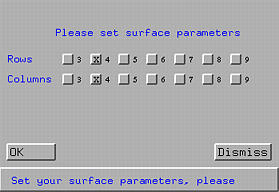If the surface type is B-spline and NURBS, a Set Surface Parameters appears:

Click the number of rows, the number of columns, the degree in the u-direction and the degree in the v-direction. Then, click OK. A flat surface of the selected type will appear on the drawing canvas.
If the selected surface is a Bézier or a rational Bézier surface, the Set Surface Parameters window only has two lines, the number of rows and the number of columns, because the degrees are determined by the row number and column number.

- Move Control Point causes the Control Point Update Window to appear. Then, you can select the current surface and use the right mouse button to select a control point of the current surface for editing (i.e., changing its position and weight, and modifying its knot vectors). See Moving Control Points, Modifying Weight, Moving Knots, and the Control Point Update Window for the details.
- Delete Control Point by Column deletes a column of control points. When this item is selected, the cursor changes to a skull. Move this skull cursor on top of any control point of the column to be deleted of the current surface and click. A complete column of control points will be removed. See Moving Control point for the details.
- Delete Control Point by Row deletes a row of control points. When this item is selected, the cursor changes to a skull. Move this skull cursor on top of any control point of the row to be deleted of the current surface and click. A complete row of control points will be removed. See Moving Control point for the details.
- Bézier Surface changes the specification of the current surface to a Bézier surface.
- Rational Bézier Surface changes the specification of the current surface to a rational Bézier surface.
- Selecting B-spline Surface changes the specification of the current surface to a B-spline surface.
- Selecting NURBS Surface changes the specification of the current surface to a NURBS surface.
